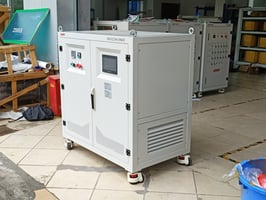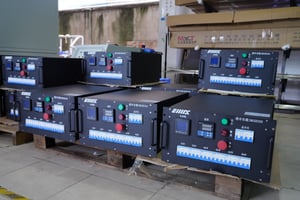In the realm of electrical power systems, reliability is paramount. Whether you manage critical...
What is a Water-Cooled Load Bank?
A water-cooled load bank is an essential tool in industries where power systems need to be tested under load conditions to ensure their reliability, performance, and safety. Unlike traditional air-cooled load banks, water-cooled variants use water as the medium to dissipate the heat generated during testing, making them ideal for high-power applications. This blog will explore what water-cooled load banks are, how they work, their key benefits, and their various applications.
Understanding the Basics of Load Banks
To understand a water-cooled load bank, it’s essential to first grasp the concept of load banks in general. A load bank is a device that mimics the electrical load a power system might experience in real-world scenarios. By simulating electrical loads, it helps in testing and validating power sources like generators, Uninterruptible Power Supplies (UPS), and transformers. Load banks ensure that these systems can handle actual power demand and work correctly under stress conditions.
Water-Cooled Load Bank: Definition
A water-cooled load bank functions like any other load bank by applying a load to a power system. The major difference lies in how it dissipates the heat generated during operation. Instead of using air for cooling, which is typical in most load banks, water-cooled load banks use water to absorb and transfer heat away from the system.
Water is a much more efficient medium for heat dissipation compared to air. This is particularly useful in high-power applications where large amounts of heat are generated and need to be managed effectively to prevent overheating and equipment damage.
How Does a Water-Cooled Load Bank Work?
Water-cooled load banks consist of electrical resistive elements that convert electrical energy into heat. These resistive elements are submerged or in close contact with a water-cooling system. As electrical current flows through the resistive elements, heat is generated, which is then absorbed by the water circulating through the cooling system.
The heated water is then either directed to a heat exchanger or dispersed into a larger water body, depending on the specific setup of the load bank. This efficient transfer of heat allows the load bank to operate continuously without the risk of overheating, even when testing systems at full capacity.
Key Components of a Water-Cooled Load Bank
- Resistive Elements: These are the core components that simulate the electrical load by converting electricity into heat.
- Water Circulation System: This system ensures a constant flow of water to absorb and remove heat from the resistive elements.
- Heat Exchanger: In some systems, a heat exchanger is used to cool down the heated water before it is recirculated.
- Control System: Load banks typically feature a control panel that allows the operator to adjust the electrical load, monitor the cooling system, and manage other operational aspects.
- Water Storage or Source: Some water-cooled load banks require an external water source, while others are equipped with internal water storage and circulation mechanisms.
Advantages of Water-Cooled Load Banks
Water-cooled load banks offer several advantages over traditional air-cooled load banks, particularly for high-power applications. Here are some key benefits:
1. Higher Power Capacity
Water-cooled load banks are often used in high-power applications because water has a much higher heat capacity than air. This means that water-cooled systems can handle larger loads and dissipate heat more efficiently, making them suitable for heavy-duty testing environments.
2. Efficient Heat Dissipation
The heat generated by electrical resistive elements can be immense, particularly in large systems. Water cooling allows for faster and more efficient heat dissipation, preventing overheating and enabling prolonged testing at high load levels.
3. Reduced Noise
Water-cooled load banks tend to operate more quietly compared to air-cooled systems. This is because they do not rely on large fans to move air across the resistive elements, which can significantly reduce noise levels, especially in enclosed environments.
4. Compact Design
Because of the efficiency of water as a cooling medium, water-cooled load banks can be designed more compactly than their air-cooled counterparts. This is a significant advantage in environments where space is at a premium.
5. Enhanced Safety
In environments where temperature control is critical, such as data centers or nuclear power plants, water-cooled load banks offer better safety. The cooling process is more reliable and predictable, reducing the risk of overheating and associated failures.
Applications of Water-Cooled Load Banks
Water-cooled load banks are used in a variety of industries and applications that require reliable power systems. Some common uses include:
1. Data Centers
Data centers require stable and reliable power sources to ensure the continuous operation of servers and other critical infrastructure. Water-cooled load banks are used to test and maintain backup power systems like UPS units and generators.
2. Marine Industry
Ships and submarines often rely on water-cooled load banks to test their electrical power systems. The availability of large quantities of water on marine vessels makes water-cooled systems an ideal choice in these environments.
3. Power Generation Plants
In power generation plants, large-scale load testing is essential to verify that generators can handle full load conditions. Water-cooled load banks are used to test and validate the performance of these generators, ensuring they can meet the demand during peak loads.
4. Renewable Energy Testing
As renewable energy sources like wind and solar become more prevalent, water-cooled load banks are being used to test and validate the power systems associated with these technologies, ensuring they can function reliably under varying load conditions.
Conclusion
Water-cooled load banks play a critical role in ensuring the reliability and safety of power systems in high-demand environments. With their efficient heat dissipation, compact design, and suitability for high-power applications, they are increasingly becoming the preferred choice for industries requiring reliable load testing solutions. Whether it's for data centers, marine vessels, or power generation plants, water-cooled load banks offer superior performance compared to traditional air-cooled systems.





